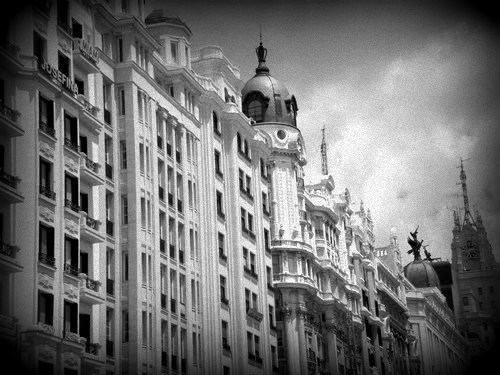Province Community of Madrid | ||
 | ||
Similar Puerta del Sol, Plaza Mayor - Madrid, Royal Palace of Madrid, Buen Retiro Park, Temple of Debod | ||
Gran Vía (literally "Great Way") is an ornate and upscale shopping street located in central Madrid. Today the street is known as the Spanish Broadway, and it is one of the streets with the most nightlife in Europe. It is known as the street that never sleeps. It leads from Calle de Alcalá, close to Plaza de Cibeles, to Plaza de España.
Contents
Map of Calle Gran V%C3%ADa, Madrid, Spain
The lively street is one of the city's most important shopping areas, with a large number of hotels and large movie theatres; however, in recent times many of these theatres are being replaced by shopping centres. The street is also noted for the grand architecture of many of the buildings.
It is considered a showcase of early 20th-century architecture, with patterns ranging from Vienna Secession style, Plateresque, Neo-Mudéjar, Art Deco, and others.
History
In the mid 19th century, Madrid's urban planners decided that a new thoroughfare had to be created, connecting the Calle de Alcalá with the Plaza de España. The project required many buildings in the centre of the city to be demolished, earning it the name of 'an axe blow on the map'. Decades after the first plans were made, construction still hadn't started and the media ridiculed the project, cynically calling it the 'Gran Vía' or 'Great Way' or 'Big Way'. Finally in 1904 it was approved and construction started a couple of years later. The last part of the street was completed in 1929.
The Gran Vía of Madrid has many historical names, both official and unofficial. Conception divided the Road in three parts. The first one was built between 1910 and 1917 and was called Calle del Conde de Peñalver ("Count of Peñalver Street"). The second part of the project commenced on 1917 and concluded on 1921. It was named Calle de Pi y Margall ("Francisco Pi y Margall Street") after a deceased politician. Construction of the third and last part of the road did not start until 1925 and was called Calle Eduardo Dato Iradier ("Eduardo Dato Street") after another politician.
Three months before the Spanish Civil War began, the Second Spanish Republic changed some street names under leftist influence. The two first parts of the avenue were called Avenida de la C.N.T. ("C.N.T. Avenue"). When the Civil War started, the avenue was renamed Avenida de Rusia ("Russia Avenue") due to the support of this country for the Spanish Republic, but soon its name would be changed to Avenida de la Unión Soviética ("Soviet Union Avenue"). However, the avenue was popularly nicknamed as Avenida de los obuses ("howitzer avenue") because of the continued bombardments by the Nationalist forces loyal to Francisco Franco. The reason for these attacks in this area was that the "Edificio de Telefónica" (the Spanish phone company) is in this street, due to its height it served the aviation as a reference point during shellings.
Just after the end of the war when the rebels entered Madrid, they renamed the road Avenida de José Antonio ("José Antonio Avenue") after one of their greatest political figures, founder of the fascist party, Falange. It wouldn't be until 1981, under Spain democracy, when the socialist mayor restored the names of 27 streets and the avenue was simply named Gran Vía ("Great Way").
Notable buildings
The new road created opportunities for architects, who had the ability to create large buildings in the latest architectural styles. The first eye catching building starting from the Calle de Alcalá is the most famous of all, the Edificio Metrópolis or Metropolis Building. The landmark was built between 1907 and 1911 after a design by the father and son architects Jules and Raymond Février. The original statue was replaced in 1975 by a statue of a winged Goddess Victory.
A bit further along the Gran Vía, on the left hand side is another landmark, the Edificio Grassy, another corner building with a small tower, built in 1917. Visible from here is the tower of the Telefónica Building, the first European skyscraper built between 1926 and 1929 for the Spanish telecommunications company. The 88-metre (290 ft) building was the tallest in Madrid and was designed by the American Louis S. Weeks.
Others buildings include:
Plazas
Farther towards the Plaza de España, the Gran Vía crosses a small square, the Plaza del Callao, named after the battle of El Callao. This square is the heart of cinematic Madrid, with about six movie theatres. One of them, the Capitol, is located in a beautiful Art Deco building. However, recent changes in building rules have allowed the reform of the theatres into more lucrative shopping centres.
The last part of the Gran Vía, constructed between 1925 and 1929 leads to the Plaza de España, a large square dominated by two skyscrapers built in the 1950s, the symmetric Edificio España and the Torre de Madrid. Here the Gran Vía becomes the Calle Princesa, leading north to the Arco de la Victoria.
